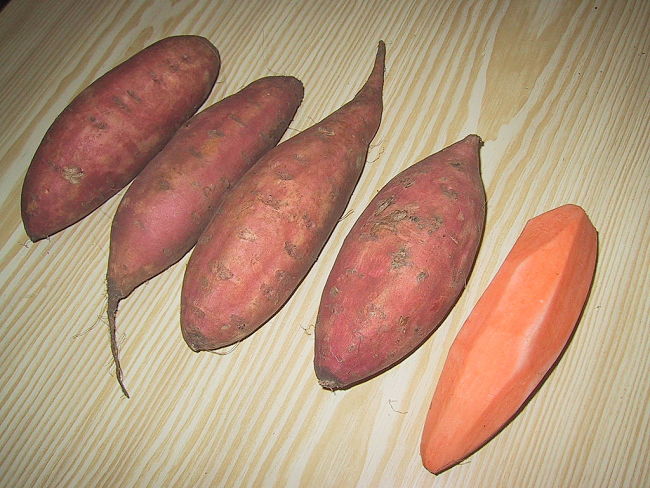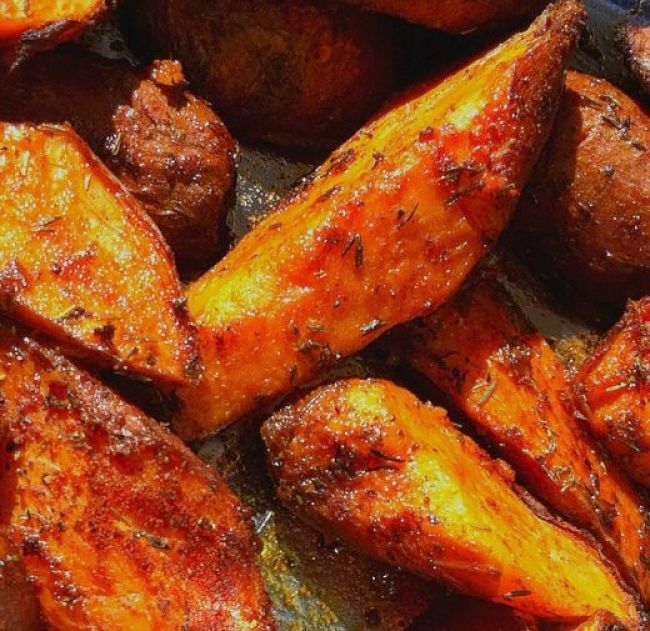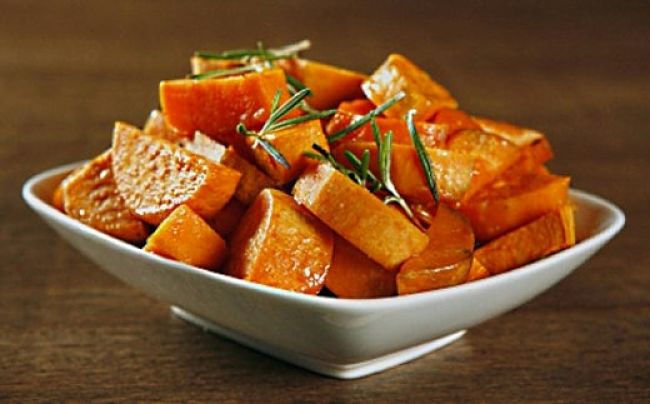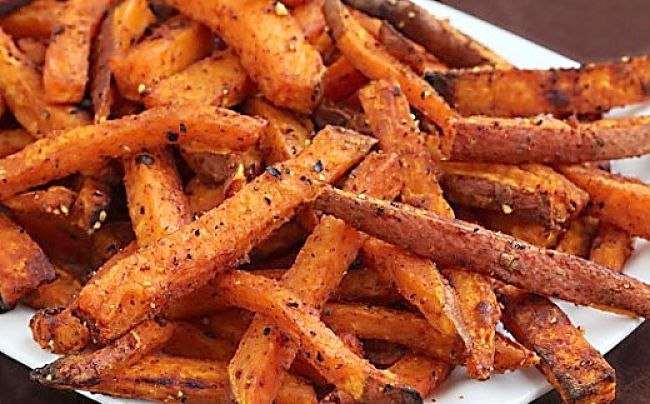Health Benefits Sweet Potatoes, Nutrition Facts, Healthy Recipes
The sweet potato is probably not used as much as it should be. It is a very versatile starchy root vegetable that has outstanding nutritional credentials.
Studies comparing the nutrients in sweet potatoes such as common potatoes, rice, wheat, corn, yams and cassava showed that sweet potatoes earned the highest overall score for nutritional values with the common potato the next highest.
The key benefits of sweet potato giving it a high-ranking were fiber content, protein, complex carbohydrates, Vitamin A and Vitamin C and the minerals Iron, and Calcium.
Sweet potato varieties with dark orange flesh are very rich in beta carotene and all varieties are rich sources of flavonoid and other anti-oxidants.
This article reviews the nutrition facts and health benefits of sweet potatoes in comparison with other root vegetables that share similar uses.
It also includes some healthy recipes to highlight their versatility.
What is Sweet Potato
Sweet potato with its starchy underground tubers belongs to the family of Convolvulaceae, and is named Ipomoea batatas. It is a herbaceous perennial vine that probably originated in Central or Southern America. It is closely related to various common garden flowers called morning glories, but is only very distantly related to the potato (Solanum tuberosum). It is sometimes confused with, and called a ‘yam’ but it not related botanically to the genuine yam (Dioscorea), which is native to Africa and Asia. Cassava (Manihot esculenta), a woody shrub, also unrelated to sweet potato is the 3rd largest source of basic carbohydrate in the tropics providing a staple diet for over 500 million people. Cassava root is a good source of carbohydrates, but a poor source of protein and other nutrients.
Sweet Potato grows well in tropical and warm temperate regions and is promoted as a good staple food for poorer communities because of its high Vitamin A content and outstanding array of nutrients. The tops are edible. The root tuber is oblong and elongated with tapering ends. Orange is the most common color but various varieties are colored brown, red, yellow purple and white.
Nutrients and Health Benefits of Sweet Potatoes
The two tables at the end of the article summarize the nutrition data and health benefits of Sweet Potato in comparison with:
- Other staple foods and grains:Common Potato, Corn, Rice, Wheat, Cassava, Yam.
- Other common foods used as alternatives: Pumpkin, Beets, ParsnipsWhat is Sweet Potato
Comparison with other staples show that sweet potato provides less calories and protein per unit weight than grain cereals and rice, but this is more than offset by it’s higher nutrient densities for vitamins and minerals.
The key aspects of Sweet Potato nutrients compared with other staples are:
- More calories (88 Cals per 100g) and fat than common potatoes, and slightly less protein (1.6g per 100g).
- Equivalent fiber levels to common potatoes, but higher than the other foods listed in the table except for wheat and yams
- Sweet potato has very high levels of Vitamin A (14,187 IU per 100g), more than twice the amount in pumpkin. All of the other foods listed have very small amounts of Vitamin A.
- Sweet potato is a rich source for B-group Vitamins (pyridoxine (vitamin B-6), pantothenic acid (vitamin B-5), thiamin (vitamin B-1), riboflavin and niacin. It has higher levels of Vitamin E, Vitamin K, but has less folate and Vitamin C than the other foods.
- Sweet potato is a rich sources of a wide range of minerals particularly Manganese, Iron and Potassium, Calcium.
- Orange and yellow sweet potato is an outstanding source of beta-carotene ( 8509 micro g per 100 g) and many other antioxidants. The overall antioxidant strength measured by oxygen radical absorbance capacity (ORAC) is 902 micro mol Trolex equivalents/100 g.
- Sweet Potato contains no saturated fats or cholesterol.
Choice and Handling of Sweet Potato
Choose fresh tubers that don’t feel soft to touch and which have intact smooth skin. Avoid flabby, discolored, damaged roots that are soft, flabby, or wilted. Avoid tubers that are sprouting.
Wash the tubers well in clean running water to remove sand and soil. Brush them clean if you are going to eat the skin. Store the washed and dried tubers in a dark, cool and well-ventilated place, or in the refrigerator. Fresh sweet potatoes can be eaten raw, but they are mostly sliced and boiled like common potatoes with a little salt in the water. They can also be sliced thinly and cooked in the microwave. They can be served mashed. They can also be baked, grilled, barbecued and fried.
Culinary Used for Sweet Potatoes
Given that sweet potatoes are a superfood in terms of nutrients it is worth expanding the way you use them in cooking apart from a vegetable side dish Below are some of the many ways you can use them.
- soups
- curries
- stews
- pasta sauce
- pizza fillings
- pies and flans
- wide range of baked goods
- baby foods
- snacks as chips, fries and wedges
- wide range of desserts
The recipes below will help you get started in expanding the way you use sweet potatoes.
Sweet Potatoes Baked Twice
- 1/4 teaspoon ground ginger
- 1/4 teaspoon ground nutmeg
- 1/2 teaspoon ground cinnamon
- 4 ounces cream cheese, at room temperature
- 4 tablespoons butter, warmed to room temperature
- 4 tablespoons brown sugar
- 6 moderate to large size sweet potatoes, scrubbed well so skins can be cooked and served as containers
- Salt and freshly ground black pepper
Place sweet potatoes on a baking sheet and bake whole in their skins in a moderate oven (375 degrees F; 190 degrees C) for about 1 hour or until soft. Remove from oven and cool. Halve the potatoes and scoop out the the flesh, set aside, and keep the skins. In medium-sized bowl with the butter, brown sugar and cream cheese. Combine well mixing in all of the spices. Add the sweet potato flesh to the bowl and mash to mix completely. Use the mixture to fill the potato skins. Place them on a baking sheet and bake for 15-20 minutes, until golden brown.
Gingered Carrot and Sweet Potato Soup
- 2 tablespoons fresh ginger, finely chopped
- 5 large carrots, peeled and sliced
- 2 cups of water
- 1 medium sweet potato, peeled and diced
- 1 cup chicken or vegetable stock
- 1 medium onion, chopped
- 1 tablespoon olive oil
- Plain low-fat yogurt (Greek-style) for a dressing when served
Heat the oil in large saucepan over high heat. Add the onion and fry until soft (generally 2 to 3 minutes). Add to cups of water and the stock and blend. Add the carrot, sweet potato and ginger. Bring the soup mixture to the boil, then reduce the heat and simmer until all the vegetables are just soft (generally about 15 minutes). Pour the contents through a sieve to separate the vegetables and solids - retain the liquid. Put vegetables, with a small amount of the broth, in a blender or food processor and puree until smooth and creamy. Pour vegetable puree and retained broth back into the saucepan and mix until smooth and well blended. Add herbs to garnish, salt and pepper to taste. Serve with a spoon full of yogurt on top.
Sweet Potato Wedges with Rosemary
- 1/4 teaspoon freshly ground black pepper
- 1 teaspoon salt
- 3 medium-size sweet potatoes, scrubbed clean so the skins can be eaten
- 1 tablespoon freshly chopped rosemary (or 2 teaspoons of dried rosemary)
- 2 tablespoons olive oil
- 2 tablespoons unsalted butter
Preheat the oven to 450 degrees F (230 degrees C). Add the butter to a small saucepan with the olive oil over medium heat to melt the butter. Mix in the rosemary.
Slice the sweet potatoes lengthwise into 1 1/2-inch (4 cm) thick wedges and transfer to a large bowl. Drizzle with the butter mixture, season with salt and pepper, and mix to coat all surfaces. Spread the wedges out on a large baking sheet in a single layer without touching. Bake on the upper shelves of the oven, turning once, for 20-30 minutes until soft inside and lightly browned on the outside. Remove from the oven and season again with salt and pepper before serving.
Spicy Sweet Potato Fries
- 2 large sweet potatoes, peeled
- 2 teaspoon paprika (preferably smoked paprika)
- 1 teaspoon cayenne pepper
- 2 teaspoon olive oil
- 1/2 teaspoon salt
Preheat an oven to 400 degrees F (200 degrees C). Slice the potatoes in half lengthwise and then cut each half into large fries. Toss the fries with the oil, paprika, cayenne pepper and salt, and spread over a baking sheet. Bake for about 35 to 45 minutes, turning once. Check to see the fries are well browned on the outside and soft all the way through. The fries can also be deep-fried.
Sweet Potato Muffins
- 1/2 cup buttermilk
- 1 egg, beaten
- 1 cup pureed or mashed cooked sweet potato
- 1/4 cup vegetable oil
- 1/4 cup melted unsalted butter
- 1/4 teaspoon salt
- 1/4 teaspoon baking soda
- 1 teaspoon ground ginger
- 2 teaspoons baking powder
- 3/4 cup sugar
- 2 1/2 cups whole-wheat flour
Heat oven to 375 degrees F (190 degrees C). Grease a 12 muffin cup baking sheet ( or use paper liners). Mix the sugar, flour, ginger, baking powder, baking soda, and salt in a bowl. Whisk the butter, oil, sweet potato, egg, and buttermilk in a second bowl. Fold wet and dry mixture together until just combined (do not over mix). Spoon the muffin cups 3/4 full. Bake for about 20 - 25 minutes.
Sweet Potato Momos Recipe
Ingredients
- For the sauce
- 2 teaspoon caster sugar
- 2 tablespoons sesame oil
- 4 tablespoons dark soy sauce
- 1 1/2 tablespoons white-wine vinegar
- 1 teaspoon chilli flakes or free chilli, finely chopped
For the dumplings
- 1/2 teaspoon salt
- 2 teaspoon dark soy sauce
- 1 bird’s-eye chilli, finely chopped
- 2 garlic cloves, peeled and crushed
- 4 spring onions, very finely sliced
- 2 tablespoons grape seed or rice bran oil
- 2 sweet potatoes, peeled and coarsely grated
- 25 dumpling wrappers (choose vegan if you like)
Simply whisk all the sauce ingredients in a small bowl and set aside. For the filling, heat 2 tablespoons of oil in a frying pan until hot. Fry the chilli and garlic for about 1 minute, until fragrant. Add the sweet potato, and stir-fry for an other minute. Next, add the soy sauce and salt, and cook for about 3 minutes more, until all the liquid has evaporated. Remove the pan from the heat and stir through the sliced spring onions. Set aside to cool.
Make up the dumplings, take one wrapper at a time and and place 1 tablespoon of the filling mixture in the centre. Dampen all around the exterior edge of the wrapper. Fold the edges over to enclose the filling. Pinch and pleat the wrapper excluding as much air as possible.
To cook the dumplings, heat 1 tablespoon of oil in a heavy saucepan on a low heat. When hot, add a single layer of momos in the pan and fry for 2 minutes, until the bottoms are golden. Next add 5 tablespoons of water and cover the pan with a lid. Leave the momos to steam for 6-7 minutes, or until the pastry is soft and the water has evaporated. Serve hot, immediately with the dipping sauce on the side.
Nutrients in Sweet Potatoes Compared with Other Staple Foods
| Nutrient content in 100g | Sweet potato | Potato | Corn | Rice | Wheat | Cassava | Yam |
|---|---|---|---|---|---|---|---|
| Energy (kJ) | 360 | 322 | 360 | 1528 | 1419 | 670 | 494 |
| Energy (Cal) | 86 | 77 | 86 | 365 | 339 | 160 | 118 |
| Protein (g) | 1.6 | 2 | 3.2 | 7.1 | 13.7 | 1.4 | 1.5 |
| Fat (g) | 0.05 | 0.09 | 1.18 | 0.66 | 2.47 | 0.28 | 0.17 |
| Saturated fatty acids (g) | 0.02 | 0.03 | 0.18 | 0.18 | 0.45 | 0.07 | 0.04 |
| Mono-unsat fatty acids (g) | 0 | 0 | 0.35 | 0.21 | 0.34 | 0.08 | 0.01 |
| Poly-unsat fatty acids (g) | 0.01 | 0.04 | 0.56 | 0.18 | 0.98 | 0.05 | 0.08 |
| Carbohydrates (g) | 20 | 17 | 19 | 80 | 71 | 38 | 28 |
| Fiber (g) | 3 | 2.2 | 2.7 | 1.3 | 10.7 | 1.8 | 4.1 |
| Calcium (mg) | 30 | 12 | 2 | 28 | 34 | 16 | 17 |
| Iron (mg) | 0.61 | 0.78 | 0.52 | 4.31 | 3.52 | 0.27 | 0.54 |
| Magnesium (mg) | 25 | 23 | 37 | 25 | 144 | 21 | 21 |
| Phosphorus (mg) | 47 | 57 | 89 | 115 | 508 | 27 | 55 |
| Potassium (mg) | 337 | 421 | 270 | 115 | 431 | 271 | 816 |
| Vitamin C (mg) | 2.4 | 19.7 | 6.8 | 0 | 0 | 20.6 | 17.1 |
| Thiamin (mg) | 0.08 | 0.08 | 0.2 | 0.58 | 0.42 | 0.09 | 0.11 |
| Riboflavin (mg) | 0.06 | 0.03 | 0.06 | 0.05 | 0.12 | 0.05 | 0.03 |
| Niacin (mg) | 0.56 | 1.05 | 1.7 | 4.19 | 6.74 | 0.85 | 0.55 |
| Pantothenic acid (mg) | 0.8 | 0.3 | 0.76 | 1.01 | 0.94 | 0.11 | 0.31 |
| Vitamin B6 (mg) | 0.21 | 0.3 | 0.06 | 0.16 | 0.42 | 0.09 | 0.29 |
| Folate Total (mcg) | 11 | 16 | 46 | 231 | 43 | 27 | 23 |
| Vitamin A (IU) | 14187 | 2 | 208 | 0 | 0 | 13 | 138 |
| Vitamin E (mg) | 0.26 | 0.01 | 0.07 | 0.11 | 0 | 0.19 | 0.39 |
| Vitamin K (mcg) | 1.8 | 1.9 | 0.3 | 0.1 | 0 | 1.9 | 2.6 |
| Beta-carotene (mcg) | 8509 | 1 | 52 | 0 | 0 | 8 | 83 |
| Lutein+zeazanthin (mcg) | 0 | 8 | 764 | 0 | 0 | 0 | 0 |
Nutrients in Sweet Potatoes Compared with Common Alternatives
| Nutrients in Serving of 100 g | Sweet Potato | Pumpkin | Beets | Parsnips |
|---|---|---|---|---|
| Energy | 86 Cal | 26 Cal | 45 cal | 75 Cal |
| Carbohydrates | 20.12 g | 6.50 g | 9.56 g | 17.99 g |
| Protein | 1.6 g | 1.0 g | 1.61 g | 1.20 g |
| Total Fat | 0.05 g | 0.1 g | 0.17 g | 0.30 g |
| Cholesterol | 0 mg | 0 mg | 0 mg | 0 mg |
| Dietary Fiber | 3 g | 0.5 g | 2.80 g | 4.9 g |
| Vitamins | ||||
| Folates | 11 mcg | 16 mcg | 109 mcg | 67 mcg |
| Niacin | 0.56 mg | 0.60 mg | 0.33 mg | 0.70 mg |
| Pantothenic acid | 0.80 mg | 0.29 mg | 0.15 mg | 0.60 mg |
| Pyridoxine | 0.21 mg | 0.06 mg | 0.07 mg | 0.90 mg |
| Riboflavin | 0.06 mg | 0.11 mg | 0.06 mg | 0.05 mg |
| Thiamin | 0.08 mg | 0.05 mg | 0.03 mg | 0.09 mg |
| Vitamin A | 14187 IU | 7384 IU | 33 IU | 0 IU |
| Vitamin C | 2.4 mg | 9.0 mg | 4.9 mg | 17 mg |
| Vitamin E | 0.26 mg | 1.06 mg | 0.04 mg | 22.5 mcg |
| Vitamin K | 1.8 mcg | 1.1 mcg | 0.2 mcg | |
| Electrolytes | ||||
| Sodium | 55 mg | 1 mg | 78 mg | 10 mg |
| Potassium | 337 mg | 340 mg | 325 mg | 375 mg |
| Minerals | ||||
| Calcium | 30 mg | 21 mg | 16 mg | 36 mg |
| Iron | 0.61 mg | 0.13 mg | 0.07 mg | 0.12 mg |
| Magnesium | 25 mg | 0.80 mg | 0.80 mg | 0.59 mg |
| Manganese | 0.26 mg | 12 mg | 23 mg | 29 mg |
| Phosphorus | 47 mg | 0.12 mg | 0.33 mg | 0.56 mg |
| Zinc | 0.30 mg | 44mg | 0.35 mg | 71 mg |
| Phyto-nutrients | ||||
| Carotene-alpha | 7 mcg | 0.3 mcg | 20 mcg | 1.8 mcg |
| Carotene-beta | 8509 mcg | 0.32 mg | 128.7 mg | 0.59 mg |




